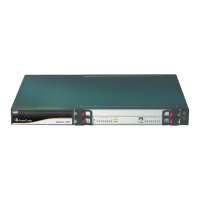Version 7.0 303 Mediant 3000
User's Manual 16. Services
terminated. By default, an ELIN can be used for PSAP callback within 30 minutes after the
call is terminated. You can change this to any value between 0 and 60:
To configure the E9-1-1 callback timeout
1. Open the Advanced Parameters page (Configuration tab > VoIP menu > SIP
Definitions > Advanced Parameters).
2. In the 'E911 Callback Timeout' field (E911CallbackTimeout), enter the required
callback timeout.
16.7.4.3 Configuring the SIP Release Cause Code for Failed E9-1-1 Calls
When a Lync client makes an emergency call, the call is routed through the Microsoft
Mediation Server to the ELIN device, which sends it on to the SIP Trunk or PSTN. In some
scenarios, the call may not be established due to either the destination (for example, busy
or not found) or the ELIN device (for example, lack of resources or an internal error). In
such a scenario, the Mediation Server requires that the ELIN device "reject" the call with
the SIP release cause code 503 "Service Unavailable" instead of the designated release
call. Such a release cause code enables the Mediation Server to issue a failover to another
entity (for example, another ELIN device), instead of retrying the call or returning the
release call to the user.
To support this requirement, you can configure the ELIN device to send a 503 "Service
Unavailable" release cause code instead of SIP 4xx if an emergency call cannot be
established:
To enable SIP response 503 upon failed E911:
1. Open the Advanced Parameters page (Configuration tab > VoIP menu > SIP
Definitions > Advanced Parameters).
2. From the 'Emergency Special Release Cause' drop-down list
(EmergencySpecialReleaseCause), select Enable.
16.7.4.4 Configuring SBC IP-to-IP Routing Rule for E9-1-1
To route incoming E9-1-1 calls to the emergency service provider's PSAP server, you need
to configure routing rules in the IP-to-IP Routing table for routing between the emergency
callers' IP Group and the PSAP server's IP Group. The only special configuration is to
define the emergency number (e.g., 911) in the 'Destination Username Prefix' parameter of
the IP Group belonging to the E9-1-1 callers. The following example shows IP-to-IP routing
rules for E9-1-1 in a Lync environment:
Figure 16-32: Example of IP-to-IP Routing Rules for Lync E9-1-1

